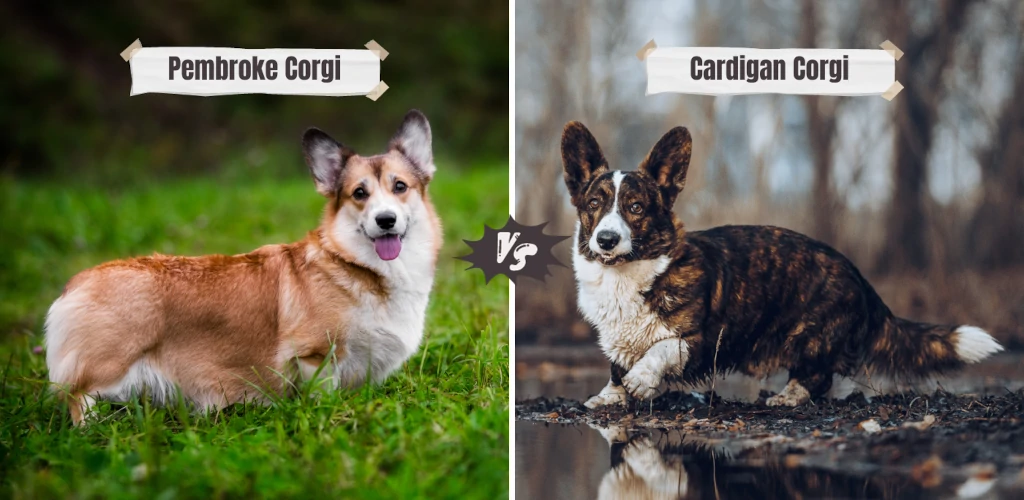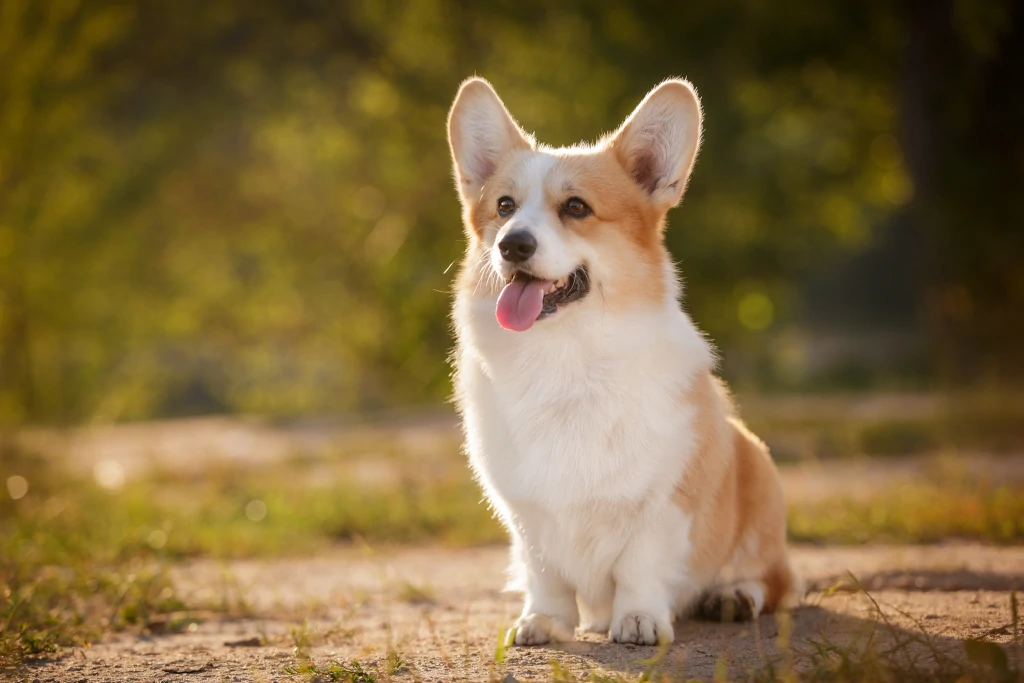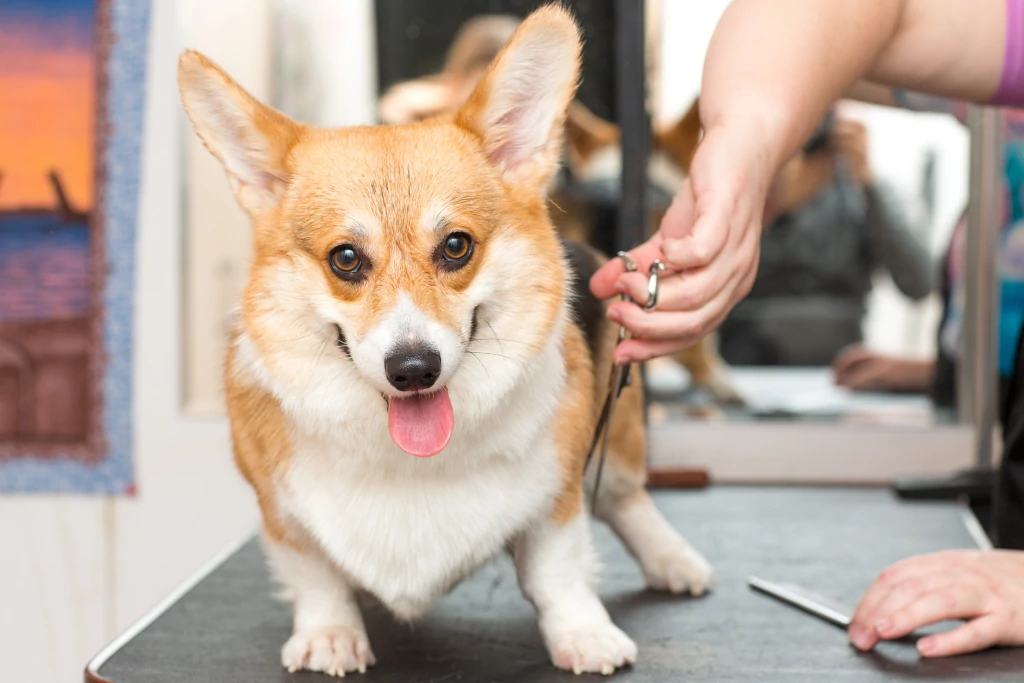
Corgis, with their iconic short legs, expressive eyes, and lovable demeanor, have captured the hearts of many.
From being the favored companions of royalty to making regular appearances in social media’s most adorable posts, these dogs have become synonymous with charm and charisma.
But beneath their unmistakable silhouette, a world of nuance awaits.
Corgis are primarily classified into two main breeds: the Pembroke and the Cardigan. While at a fleeting glance, they might seem indistinguishable, delve a little deeper, and you’ll discover a tapestry of differences interwoven with tales of ancient Celtic societies, diverse temperaments, and unique features.
In this article of Pembroke vs. Cardigan Corgis, we journey into understanding what sets them apart and, perhaps more importantly, what might make one of them the perfect addition to your family.
| Breed Comparison | Pembroke Corgi | Cardigan Corgi |
|---|---|---|
| Weight | Up to 30 pounds | 25 - 38 pounds |
| Height | 10 - 12 inches | 10.5 - 12.5 inches |
| Size | Small | Small |
| Temperament | Playful, friendly, outgoing | Loyal, alert, intelligent |
| Trainability | 4.0 out of 5.0 stars4.0 | 4.0 out of 5.0 stars4.0 |
| Energy Level | 4.0 out of 5.0 stars4.0 | 3.0 out of 5.0 stars3.0 |
| Life Expectancy | 12 - 13 years | 12 - 15 years |
| Shedding | 5.0 out of 5.0 stars5.0 | 5.0 out of 5.0 stars5.0 |
| Hypoallergenic | No | No |
| Puppy Costs | $1,000 - $2,500 | $1,000 - $3,000 |
Origins and Historical Significance
The Corgi’s legacy is as rich as the vibrant histories of Wales and the surrounding Celtic lands from which they hail.
The very name “Corgi” is believed to have Celtic roots, with “cor” meaning “dwarf” and “gi” translating to “dog.” But, as with many ancient breeds, the exact origin is draped in a blend of fact and folklore.
The Cardigan Welsh Corgi, characterized by its older lineage, traces its ancestry back over three thousand years, per the Cardigan Welsh Corgi Club. Legend has it that these dogs were gifted by fairies and elves, a tale inspired by the characteristic markings on their coats, often whimsically referred to as “fairy saddles.”
The Cardigan’s historical significance is deeply tied to the Celts who brought them to Wales during their migration from Central Europe. These robust dogs, with their strong herding instincts, were invaluable to Welsh farmers, herding cattle and guarding homesteads.
On the other hand, the Pembroke Welsh Corgi has a more recent history, believed to have been introduced to Wales by Flemish weavers in the 10th century. With their arrival, they brought small imported dogs that were then interbred with the local canine population, leading to the birth of the Pembroke breed we recognize today.
Unlike the Cardigan, the Pembroke quickly gained favor with British royalty, most notably with Queen Elizabeth II, who received her first Pembroke Corgi named “Dookie” as a child.
Despite their differing origins, both Corgi dog breeds have cemented their places in Welsh culture and beyond. Whether it’s the Cardigan, with its ancient ties to Celtic folklore, or the Pembroke, with its royal associations, each offers a unique glimpse into the storied past of the British Isles.
| Key Differences | Pembroke Corgi | Cardigan Corgi |
|---|---|---|
| Origin | Influenced by Flemish spitz-like dogs introduced by Flemish weavers in the 10th century | Ancient Celtic roots, over three thousand years old |
| Tales & Folklore | Favored by British royalty, notably Queen Elizabeth II | Gifted by fairies and elves; "fairy saddles" on their coat |
| Historical Role | Herding cattle and guarding homesteads | Herding cattle and guarding homesteads |
** Comparison Table: Key Differences in Origins
Physical Differences: Pembroke vs. Cardigan Corgi

When it comes to Corgis, their enchanting appearance is undoubtedly a key part of their charm.
However, upon closer inspection, distinguishing features between the Pembroke and Cardigan breeds become evident. While both breeds share the hallmark short legs and elongated body that Corgis are adored for, many subtle distinctions set them apart.
Starting with their overall stature, the Cardigan Corgi is generally larger with a slightly more robust frame compared to its Pembroke counterpart. A Cardigan’s bone structure is more heavyset, built for endurance and long days of herding on the farms.
The Pembroke Corgi, on the other hand, possesses a more refined appearance. Their bodies are often more streamlined, and they tend to be a bit lighter on their feet.
One of the most recognizable differences is the tail. While Pembroke’s tail is often docked or naturally shorter, appearing almost bob-like, the Cardigan flaunts a long, bushy tail that elegantly drapes down.
Moving to the face, the Cardigan’s ears are slightly larger and rounded at the tip, while the Pembroke’s ears stand taller, pointier, and more erect.
Finally, the variations in their coat colors and patterns can also offer clues. Though both breeds come in an array of colors, the American Kennel Club (AKC) recognizes a broader shade for the Cardigan, including shades not seen in the Pembroke, such as brindle, gray, liver, blue merle, brindle merle, red merle, sable merle, and white merle.
| Key Differences | Pembroke Corgi | Cardigan Corgi |
|---|---|---|
| Height | 10 - 12 inches | 10.5 - 12.5 inches |
| Male Weight | Up to 30 pounds | 30 - 38 pounds |
| Female Weight | Up to 28 pounds | 25 - 34 pounds |
| Size & Build | Smaller, more refined stature | Larger and more robust frame |
| Tail | Docked or naturally shorter tail | Long, bushy tail |
| Ears | Pointier | Rounder |
| Coat Colors |
Black & Tan Fawn Red Sable |
Black & White Blue Merle & White Gray & White Liver & White Red & White Red Merle & White Sable & White Sable Merle & White Brindle & White Brindle Merle & White White Merle |
| Bone Structure | Lighter bone structure | Heavier, built for endurance |
** Comparison Table: Key Differences in Physical Characteristics
Temperament and Personality: Pembroke vs. Cardigan Corgi

Diving into the world of Corgis, one might be tempted to think their similarities end in their physical appearances. However, when it comes to temperament and behavior, the distinctions between the Pembroke and Cardigan breeds are equally fascinating.
The Pembroke Corgi is known for its vivacious spirit. Often described as outgoing, these dogs exhibit a playful and affectionate nature that makes them quick to warm up to both family members and strangers.
Pembrokes are intelligent and eager to please, traits that often translate into them being easily trainable. Their alertness and sensitivity to their surroundings make them excellent watchdogs, but it’s their sociability that often shines through.
In contrast, the Cardigan Corgi carries a slightly more reserved demeanor. While they’re every bit as loving as the Pembroke, Cardigans tend to be more observant and may take a bit longer to warm up to unfamiliar faces.
Their protective nature, a testament to their history as farm dogs, means they are vigilant guardians of their homes and loved ones. Cardigans are also known for their strong sense of independence, which, combined with their intelligence, means they often approach situations with a thoughtful, discerning attitude.
Though both the Cardigan and the Pembroke are highly intelligent and can exhibit a streak of stubbornness, their approach to unfamiliar situations and interactions with strangers can be markedly different.
You May Also Like: How To Get My Dog To Stop Pulling
| Key Differences | Pembroke Corgi | Cardigan Corgi |
|---|---|---|
| Nature | Playful, affectionate, eager to please | Observant, thoughtful, independent |
| Guardian Instinct | Alert watchdog, but more sociable | Strong protective instincts, vigilant guardian |
| Initial Approach to Strangers | Outgoing, friendly from the outset | More reserved, takes time to warm up |
| Social Interactions | Typically gets along well with other pets and children | Tends to be more selective in friendships, loyal to their pack |
** Comparison Table: Key Differences in Temperament and Behavior
Energy Levels: Cardigan vs. Pembroke Corgi

Corgis, with their lively disposition and herding heritage, are active herding dogs that thrive on regular exercise and mental stimulation. But how do the activity levels of the Pembroke and Cardigan Welsh Corgis differ?
The Pembroke Welsh Corgi is a bundle of energy. Their spirited nature makes them ever-ready for playtime, walks, or even short bursts of agility training. These dogs love to engage in activities that challenge both their mind and body.
While they’re always up for a game of fetch, offering them toys or puzzles that stimulate their intellect is equally crucial. Daily walks combined with some playtime are usually sufficient for the Pembroke.
On the other hand, the Cardigan Welsh Corgi, while also descending from herding stock, exhibits a somewhat more reserved energy profile. They certainly enjoy their play and exercise sessions but might be content with slightly less vigorous routines compared to the Pembroke.
Cardigans enjoy challenges, so incorporating mentally stimulating games or tasks into their routine can be as beneficial as physical exercise. This not only caters to their physical needs but also satisfies their intelligent and analytical nature.
Without adequate activity, both breeds can become restless or even adopt undesirable behaviors out of boredom.
Also, one thing to note is that due to their relatively short stature, care should be taken not to over-exert them, especially in very hot or cold climates. And because of their long backs, you’ll want to choose the right exercise types to prevent putting undue strain on their spines.
You May Also Like: How To Go Camping With Dogs (With Infographic)
| Key Differences | Pembroke Corgi | Cardigan Corgi |
|---|---|---|
| Energy Levels | High, spirited and playful | Moderate to high, but slightly more reserved |
| Exercise Needed | Requires consistent, longer periods of activity | May be content with slightly shorter sessions |
| Daily Exercise Duration | 60 to 90 minutes | 1 hour |
| Mental Stimulation | Enjoys challenges but prioritizes physical activity | Highly beneficial, enjoys tasks and challenges |
** Comparison Table: Key Differences in Energy Levels
Training: Cardigan vs. Pembroke Corgi

Training any dog requires patience, understanding, and a consistent approach. With Corgis, given their intelligence and spirited nature, training can be a delightful experience, albeit with some breed-specific nuances to consider.
The Pembroke Corgi is often lauded for its eagerness to please, making it generally receptive to training. These dogs catch on quickly, and with positive reinforcement techniques, they can learn various commands and tricks.
However, their playful nature means they can sometimes be distracted, so short, engaging training sessions often yield the best results. Socialization from a young age is crucial, ensuring the Pembroke grows into a well-rounded adult dog.
Conversely, the Cardigan Corgi brings a touch of independence to the training table. While they are equally intelligent, their independent streak can sometimes be mistaken for stubbornness.
The key with Cardigans is to establish leadership early on. They respect consistency and clear guidance. And like the Pembroke, early socialization is vital to ensure they’re comfortable in various environments.
You May Also Like: Why Do Dogs Pull On The Leash?
| Aspect | Pembroke Corgi | Cardigan Corgi |
|---|---|---|
| Intelligence | High | High |
| Trainability | High | High |
| Stubbornness Level | Slightly more stubborn than Cardigans | Moderate |
** Comparison Table: Key Differences in Training
Health and Lifespan: Cardigan Welsh Corgi vs. Pembroke Welsh Corgi

Like all breeds, Corgis come with their own set of health concerns and typical lifespans. Recognizing these allows owners to provide the best possible care and ensure a long, healthy life for their beloved pets.
The Pembroke Welsh Corgi typically enjoys a lifespan of around 12 to 13 years. Being a purebred, certain genetic conditions are more prevalent in Pembrokes.
They can be predisposed to elbow and hip dysplasia, a joint condition that may lead to arthritis. Another common concern is progressive retinal atrophy, which affects the eyes.
They are also at risk for degenerative myelopathy, a spinal cord disease. Given their robust appetite, obesity is a concern that can exacerbate other health conditions, especially those relating to their spine and joints.
The Cardigan Welsh Corgi, with its slightly more substantial frame, tends to have a similar lifespan, ranging from 12 to 15 years. They share the health concerns with Pembroke Welsh Corgis but are generally healthier than their Pembroke cousins.
Regular check-ups, a balanced diet, and appropriate exercise can help mitigate some of these health risks. Also, it’s essential for potential Corgi owners to work with a reputable breeder who prioritizes health screenings and responsible breeding practices to reduce the risk of genetic conditions.
You May Also Like: Why Won’t Your Dog Sleep?
| Aspect | Pembroke Corgi | Cardigan Corgi |
|---|---|---|
| Typical Lifespan | 12 to 13 years | 12 to 15 years |
| Common Health Issues | Hip & elbow dysplasia, progressive retinal atrophy, degenerative myelopathy, obesity | Hip & elbow dysplasia, progressive retinal atrophy, degenerative myelopathy, obesity |
** Comparison Table: Key Differences in Health and Lifespan
Diet

When catering to the dietary needs of your Corgi, understanding breed-specific requirements can make all the difference. Nutrition plays a pivotal role in a dog’s overall health, longevity, and quality of life.
Given their active nature and herding lineage, Corgis, whether Pembroke or Cardigan, require a well-balanced diet to fuel their energetic lives.
For the Pembroke Corgi, their generally active and playful nature means they benefit from a diet with high-quality animal-based protein that supports sustained energy release.
Pembrokes are especially prone to obesity due to their love for food and treats, so portion control and regular weight checks are essential. Supplements like glucosamine can be beneficial, given their long backs and potential for joint issues.
Cardigan Corgis, while having a slightly larger frame and robust build, has similar caloric needs. And like the Pembroke, they can be prone to weight gain if overfed or if they lead a sedentary lifestyle.
Cardigans, with their analytical nature, might enjoy puzzle feeders that challenge them mentally while they eat. They also benefit from joint-supporting supplements, especially if they’re involved in agility or herding activities.
You May Also Like: Why Won’t Your Dog Eat?
| Aspect | Pembroke Corgi | Cardigan Corgi |
|---|---|---|
| Daily Kibble Intake | 1.5 to 2 cups | 1.5 to 2 cups |
| Meal Frequency | Twice a day | Twice a day |
** Comparison Table: Key Differences in Diet
Grooming Needs: Cardigan Welsh Corgi vs. Pembroke

Grooming not only ensures your Corgi looks dapper but is also vital for their overall health and well-being. Both types of Corgis boast a double coat, requiring specific attention to maintain their luster and health.
The Pembroke’s coat has a finer, smoother texture. These dogs shed throughout the year, with notable “shedding seasons,” typically in spring and fall. Regular brushing, at least a couple of times a week, can help manage this shedding, reduce matting, and distribute essential oils through the coat.
Bathing is to be done as required as too frequent baths might strip the coat of its natural oils. Attention to their ears, nails, and dental health rounds out the Pembroke’s grooming routine.
In contrast, the Cardigan Corgi has a slightly harsher outer coat. While they also experience regular shedding, their coat texture might trap dead hair, making routine brushing essential to prevent matting and skin issues.
Their grooming regimen is similar to the Pembroke’s. Regular ear checks, nail trims, and dental care are as crucial for the Cardigan as they are for the Pembroke.
You May Also Like: Why Is My Dog Biting Their Nails: Common Possible Reasons & Solutions
| Key Differences | Pembroke Corgi | Cardigan Corgi |
|---|---|---|
| Coat Texture | Smoother | Slightly harsher |
| Shedding Amount | Heavy | Heavy |
| Brushing Frequency | At least 2-3 times a week, more during shedding seasons | At least 2-3 times a week, more during shedding seasons |
| Bathing Frequency | As needed | As needed |
** Comparison Table: Key Differences in Grooming and Maintenance
Puppy Price: Pembroke Welsh Corgi vs. Cardigan Welsh Corgi

Selecting the perfect Corgi puppy is both an emotional and financial decision. Understanding the pricing nuances between the two different types of Corgis can help prospective owners make informed choices.
Contrary to popular belief, despite the Pembroke’s spotlight in popular culture, the Cardigan Welsh Corgi, being the less common of the two breeds, often commands a higher price. This rarity is due to various factors:
- Fewer breeders specialize in Cardigans.
- They have a more diverse gene pool.
- Their breeding can sometimes be more intricate.
Additionally, the Cardigan’s larger size and distinct appearance, characterized by its longer tail and slightly larger ears, can drive demand from enthusiasts seeking a less “mainstream” Corgi.
Conversely, the Pembroke Welsh Corgi, while immensely popular and frequently showcased in media, is more widely available.
Their increased visibility and higher breeding numbers generally translate to a slightly more accessible price point. However, high-demand periods or particular pedigrees can still see prices soar.
| Aspect | Pembroke Corgi | Cardigan Corgi |
|---|---|---|
| Average Price Range | $1,000 to $2,500 | $1,000 to $3,000 |
| Influence on Price | Popularity, media presence, higher breeding numbers | Rarity, diverse gene pool, specialized breeding |
** Comparison Table: Key Differences in Puppy Price
Note: The price of a puppy can vary significantly based on factors such as breeding practices, lineage, location, and demand. It's also essential to remember that the initial cost of the puppy is just the beginning. Vet visits, training, grooming, and general care will add to the lifetime cost of owning these delightful dogs.
Which Corgi is Best For You? The Pembroke or Cardigan Corgi?
Embarking on the journey of Corgi ownership is undoubtedly thrilling. These endearing canines, with their spirited personalities and unique statures, can bring immense joy into any household.
However, understanding the subtle differences between the Pembroke and Cardigan Welsh Corgis is crucial in determining the right fit for your lifestyle.
Firstly, reflect upon your living situation and what you desire in a canine companion. Are you drawn to the classic, tailless appearance of the Pembroke or the more fox-like allure of the Cardigan with its elongated tail? Each breed brings its distinct charm, but both are bound to captivate your heart.
Temperament is another vital consideration. While both breeds are known for their intelligence and spirited nature, slight variations in their behavior might make one more suited to certain households.
Families with young children, for instance, might appreciate the Cardigan’s typically more laid-back nature. In contrast, those looking for a more playful and occasionally mischievous companion might gravitate towards the Pembroke.
Additionally, take stock of your activity levels. Both Corgi breeds require ample exercise and mental stimulation, but their individual needs can vary. Pembrokes, often being more active, require more playtime than their Cardigan counterparts.
Lastly, remember that whichever breed you choose, a Corgi requires love, attention, and a commitment to their well-being. Both breeds bring with them certain health concerns and grooming needs that prospective owners should be aware of.
In conclusion, the decision between a Pembroke and Cardigan Welsh Corgi hinges on personal preferences, lifestyle, and the kind of canine companion you envision by your side. Whichever you choose, rest assured you’re gaining a loyal, loving, and endlessly entertaining friend.
Frequently Asked Questions About Pembroke vs. Cardigan Corgi
Q1. What are the main physical differences between Pembroke and Cardigan Corgis?
A: The primary physical distinctions are that Cardigans are slightly bigger in size, have larger ears, and, most notably, a long tail. Pembrokes, on the other hand, are often tail-less or have a very short tail and are generally smaller in stature.
Q2. Which type of Corgi is calmer?
A: While individual temperaments can vary, the Cardigan Welsh Corgi is typically considered the calmer of the two types of corgis. They often possess a slightly more laid-back demeanor compared to the energetic Pembroke.
Q3. Are Cardigan Corgis rare?
A: Yes, Cardigan Welsh Corgis are less common than Pembrokes, making them relatively rarer. Fewer breeders specialize in Cardigans, and their distinct characteristics can lead to a niche demand.
Q4. Can Pembroke Corgis have tails?
A: While the traditional Pembroke Welsh Corgi is known for its tail-less or short-tailed appearance, Pembrokes are occasionally born with tails. However, even if a Pembroke Corgi is born with a tail, it is generally either docked or removed in accordance with breed standards.
Q5. Are Pembroke Corgis friendly?
A: Absolutely! Pembroke Corgis are known for their friendly and affectionate nature. They are outgoing, enjoy being around people, and typically get along well with children and other pets.
Q6. Which type of Corgi is more popular?
A: The Pembroke Welsh Corgi tends to be more visible in media and pop culture, often due to their association with British royalty, especially Queen Elizabeth II, and therefore, more popular.

